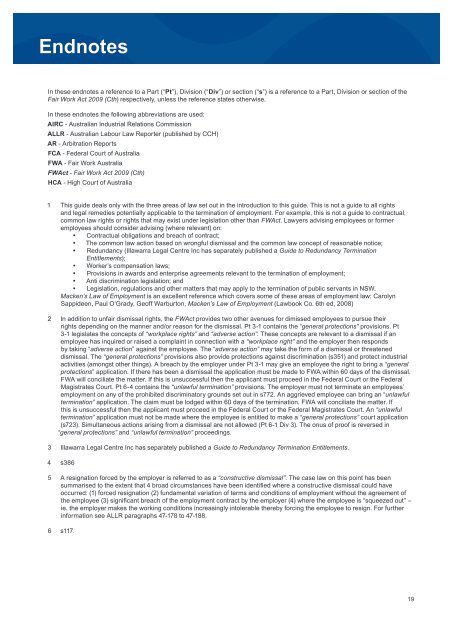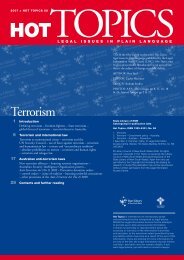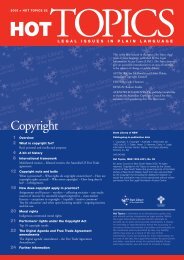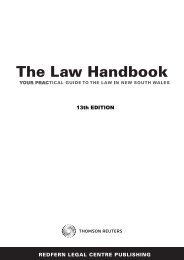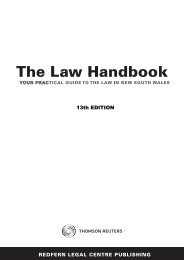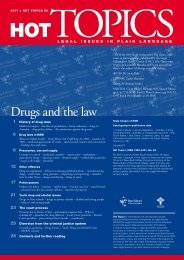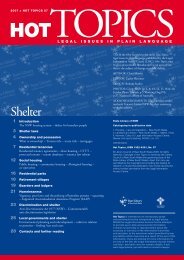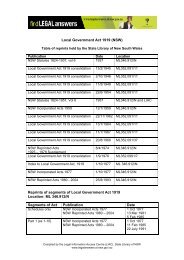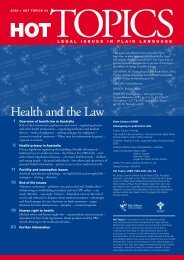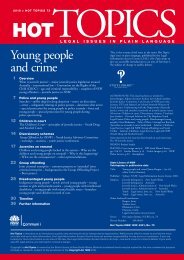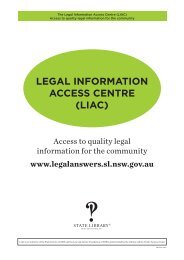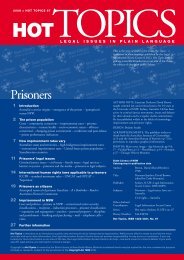Guide to termination and unfair dismissal rights of - Legal ...
Guide to termination and unfair dismissal rights of - Legal ...
Guide to termination and unfair dismissal rights of - Legal ...
- No tags were found...
You also want an ePaper? Increase the reach of your titles
YUMPU automatically turns print PDFs into web optimized ePapers that Google loves.
EndnotesIn these endnotes a reference <strong>to</strong> a Part (“Pt”), Division (“Div”) or section (“s”) is a reference <strong>to</strong> a Part, Division or section <strong>of</strong> theFair Work Act 2009 (Cth) respectively, unless the reference states otherwise.In these endnotes the following abbreviations are used:AIRC - Australian Industrial Relations CommissionALLR - Australian Labour Law Reporter (published by CCH)AR - Arbitration ReportsFCA - Federal Court <strong>of</strong> AustraliaFWA - Fair Work AustraliaFWAct - Fair Work Act 2009 (Cth)HCA - High Court <strong>of</strong> Australia1 This guide deals only with the three areas <strong>of</strong> law set out in the introduction <strong>to</strong> this guide. This is not a guide <strong>to</strong> all <strong>rights</strong><strong>and</strong> legal remedies potentially applicable <strong>to</strong> the <strong>termination</strong> <strong>of</strong> employment. For example, this is not a guide <strong>to</strong> contractual,common law <strong>rights</strong> or <strong>rights</strong> that may exist under legislation other than FWAct. Lawyers advising employees or formeremployees should consider advising (where relevant) on:• Contractual obligations <strong>and</strong> breach <strong>of</strong> contract;• The common law action based on wrongful <strong>dismissal</strong> <strong>and</strong> the common law concept <strong>of</strong> reasonable notice;• Redundancy (Illawarra <strong>Legal</strong> Centre Inc has separately published a <strong>Guide</strong> <strong>to</strong> Redundancy TerminationEntitlements);• Worker’s compensation laws;• Provisions in awards <strong>and</strong> enterprise agreements relevant <strong>to</strong> the <strong>termination</strong> <strong>of</strong> employment;• Anti discrimination legislation; <strong>and</strong>• Legislation, regulations <strong>and</strong> other matters that may apply <strong>to</strong> the <strong>termination</strong> <strong>of</strong> public servants in NSW.Macken’s Law <strong>of</strong> Employment is an excellent reference which covers some <strong>of</strong> these areas <strong>of</strong> employment law: CarolynSappideen, Paul O’Grady, Ge<strong>of</strong>f Warbur<strong>to</strong>n, Macken’s Law <strong>of</strong> Employment (Lawbook Co. 6th ed, 2008)2 In addition <strong>to</strong> <strong>unfair</strong> <strong>dismissal</strong> <strong>rights</strong>, the FWAct provides two other avenues for dimissed employees <strong>to</strong> pursue their<strong>rights</strong> depending on the manner <strong>and</strong>/or reason for the <strong>dismissal</strong>. Pt 3-1 contains the “general protections” provisions. Pt3-1 legislates the concepts <strong>of</strong> “workplace <strong>rights</strong>” <strong>and</strong> “adverse action”. These concepts are relevant <strong>to</strong> a <strong>dismissal</strong> if anemployee has inquired or raised a complaint in connection with a “workplace right” <strong>and</strong> the employer then respondsby taking “adverse action” against the employee. The “adverse action” may take the form <strong>of</strong> a <strong>dismissal</strong> or threatened<strong>dismissal</strong>. The “general protections” provisions also provide protections against discrimination (s351) <strong>and</strong> protect industrialactivities (amongst other things). A breach by the employer under Pt 3-1 may give an employee the right <strong>to</strong> bring a “generalprotections” application. If there has been a <strong>dismissal</strong> the application must be made <strong>to</strong> FWA within 60 days <strong>of</strong> the <strong>dismissal</strong>.FWA will conciliate the matter. If this is unsuccessful then the applicant must proceed in the Federal Court or the FederalMagistrates Court. Pt 6-4 contains the “unlawful <strong>termination</strong>” provisions. The employer must not terminate an employees’employment on any <strong>of</strong> the prohibited discrimina<strong>to</strong>ry grounds set out in s772. An aggrieved employee can bring an “unlawful<strong>termination</strong>” application. The claim must be lodged within 60 days <strong>of</strong> the <strong>termination</strong>. FWA will conciliate the matter. Ifthis is unsuccessful then the applicant must proceed in the Federal Court or the Federal Magistrates Court. An “unlawful<strong>termination</strong>” application must not be made where the employee is entitled <strong>to</strong> make a “general protections” court application(s723). Simultaneous actions arising from a <strong>dismissal</strong> are not allowed (Pt 6-1 Div 3). The onus <strong>of</strong> pro<strong>of</strong> is reversed in“general protections” <strong>and</strong> “unlawful <strong>termination</strong>” proceedings.3 Illawarra <strong>Legal</strong> Centre Inc has separately published a <strong>Guide</strong> <strong>to</strong> Redundancy Termination Entitlements.4 s3865 A resignation forced by the employer is referred <strong>to</strong> as a “constructive <strong>dismissal</strong>”. The case law on this point has beensummarised <strong>to</strong> the extent that 4 broad circumstances have been identified where a constructive <strong>dismissal</strong> could haveoccurred: (1) forced resignation (2) fundamental variation <strong>of</strong> terms <strong>and</strong> conditions <strong>of</strong> employment without the agreement <strong>of</strong>the employee (3) significant breach <strong>of</strong> the employment contract by the employer (4) where the employee is “squeezed out” –ie. the employer makes the working conditions increasingly in<strong>to</strong>lerable thereby forcing the employee <strong>to</strong> resign. For furtherinformation see ALLR paragraphs 47-178 <strong>to</strong> 47-188.6 s117.19


